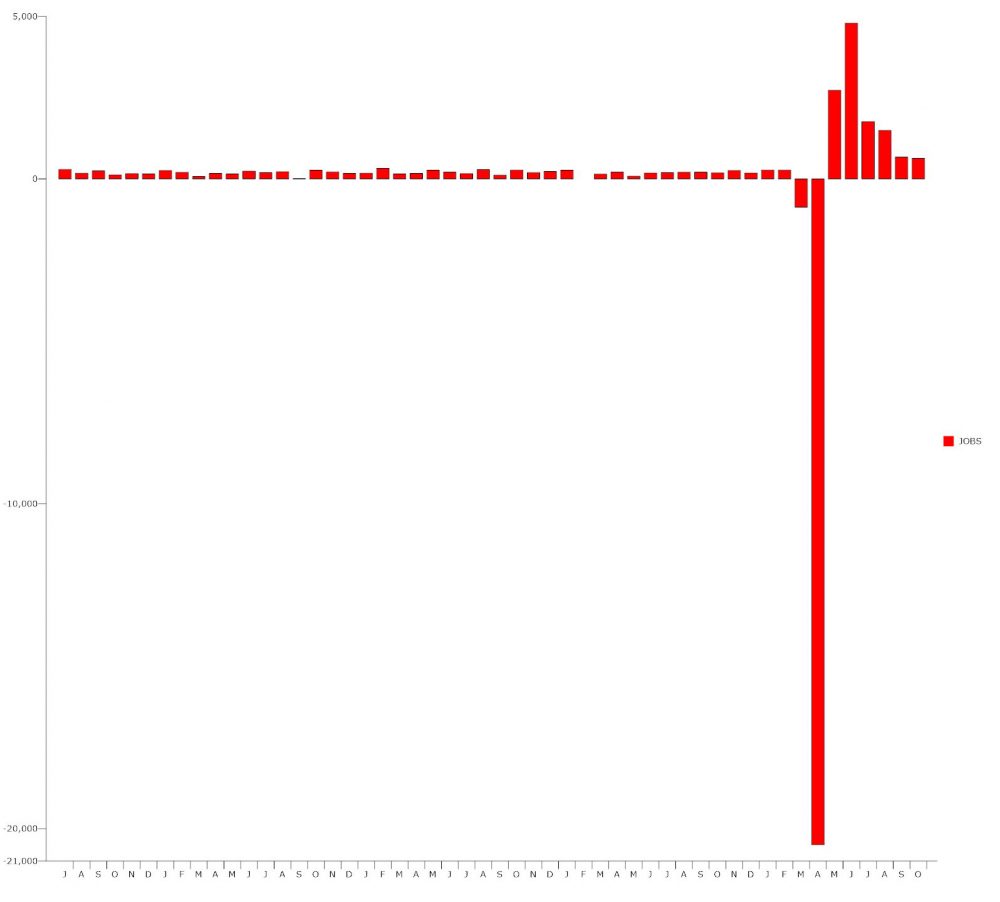
The U.S. unemployment rate fell a full percentage point in October, to 6.9 percent, as the economy continued its steady if fitful recovery from coronavirus-related job losses, adding 638,000 jobs in October. The gains would have been higher had it not been for the loss of 147,000 temporary Census jobs.
The economy has now recovered roughly half the 22 million jobs lost last spring. More than 11 million Americans remain out of work. Before the pandemic, the unemployment rate was at 3.5 percent, with 5.8 million Americans out of work.
Among the unemployed, the number of persons on temporary layoff fell by 1.4 million, to 3.2 million, after reaching 18.1 million in April. At 3.7 million, permanent job losses are 2.4 million higher than in February. While the number of people who usually work full time rose by 1.2 million, to 123.6 million, the number of so-called involuntary part-time workers rose for the first time in six months by 383,000, to 6.7 million.
Involuntary part-timers are those who are looking for full-time work but couldn’t find any, or had their hours cut back. They are considered under-employed. When their numbers are added to the number of discouraged workers who have dropped out of the labor force, the Labor Department’s U-6, or alternative, unemployment and underemployment rate rises to 12.1 percent. It was 6.5 percent a year ago. In Florida, it’s 12.8 percent.
The federal government’s supplemental $600-a-week unemployment benefit ran out in July. In Florida, a state with one of the lowest unemployment benefits in the nation, the maximum $275-a-week unemployment benefit ran out for workers after 12 weeks.
In a reflection of the changed workplace, 21.2 percent of workers worked remote in October, down from 22.7 percent in September. But 15.1 million people reported that they had been unable to work because their employer closed or lost business due to the pandemic–that is, they did not work at all or worked fewer hours at some point in the last four weeks due to the pandemic. It’s a high number, but significantly down from 19.4 million in September. Among those, 11.7 percent received at least some pay from their employer for the hours not worked, up from 10.3 percent in September.
Another 3.6 million persons not in the labor force in October were prevented from looking for work due to the pandemic. This is down from 4.5 million in September. But the exclusion of those 3.6 million people artificially lowers the official unemployment rate: To be counted as unemployed, by definition, individuals must either be actively looking for work or on temporary layoff.
Employment in leisure and hospitality, one of the sectors most severely hit by the pandemic, especially in Florida, increased by 271,000 in October, returning a total of 4.8 million jobs since April, but still down by 3.5 million since February.
Professional and business services added 208,000 jobs, retail trade added 104,000 jobs, a rise of 1.9 million since April but 499,000 below the February level. Construction added 84,000 jobs in October, health care and social assistance added 79,000, transportation and warehousing added 63,000. Air transportation shed 18,000 jobs. Manufacturing added 38,000 jobs. But government employment fell by 268,000, including those Census workers. Local and state government also saw big losses (98,000 and 61,000). Average hourly earnings for all employees on private nonfarm payrolls increased by 4 cents to $29.50.





























Wow says
Funny how this is posted after the election.
FlaglerLive says
Nothing “funny” about it. The Labor Department posts the previous month’s unemployment report the first Friday of the month at 8:30 a.m. has been doing so for decades.
Wallingford says
What I find confusing is every week it is stated that a specific number of jobs have been added to the Workforce which we are supposed to celebrate while, one day earlier, every week a higher number of applicants file for first time unemployment claims. Isn’t that a Net Reduction of Jobs? In addition, many of the Retail Sector increases, especially at this time of the year, are temporary holiday season employees who will be terminated in January after the Return period of holiday purchases.
Maybe one day in the not too distant future we can return to the good old days
Agkistrodon says
Yeah those jobs will be gone soon enough. Not to worry though, the federal government will take care of you, and joe, he will cure covid shortly after swearing in….oh btw, as a retired federal employee, I’m am truly certain that the Federal government and its large supply of unfireable employees will take very very good care of you….if they can pull themselves away from their social media………..good luck, you are going to be needing it. And get ready for taxes, of course. You’ll see, soon enough.